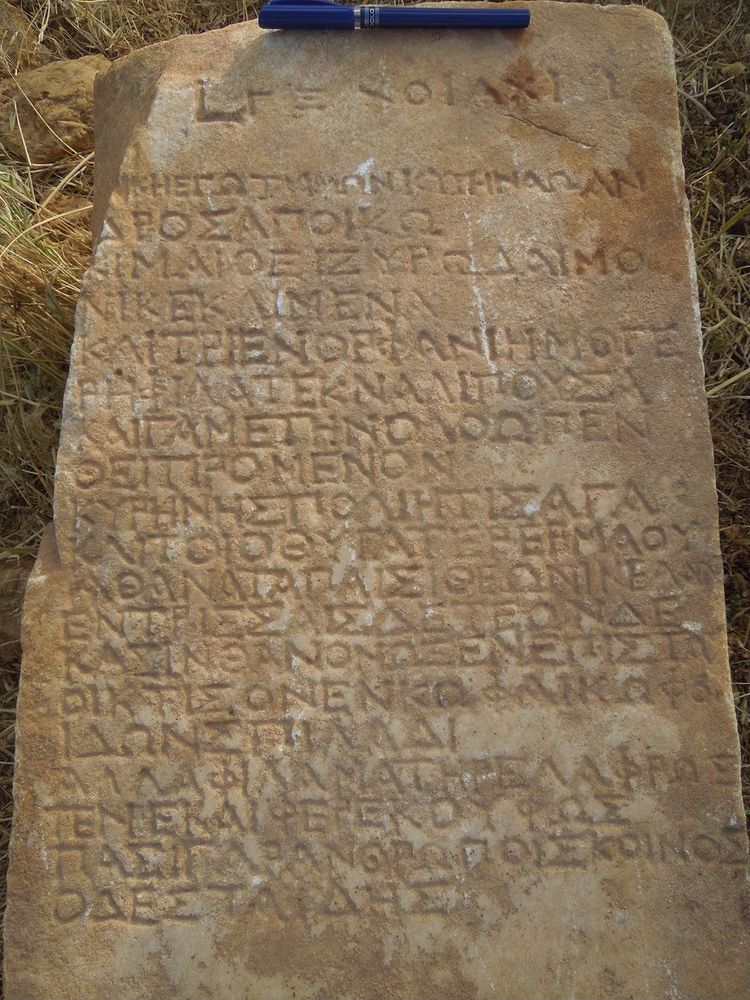Support: Plain stele of local limestone, only slightly split off at the upper left edge
(w: 0.35 × h: 1.07 × d: 0.24).
Layout: Inscribed on one shorter centered line, then a series of 19 lines on the whole width, and lower two further lines.
Letters: Letters height not measured, of three different sizes: the letters at line 2 are smaller and more pressed together than at
lines 1 and 3-20, whereas they are larger at lines 21-22. All letters have a classical ductus, including a four-stroke sigma
with parallel bars and horse-shoe omega; alpha has more or less broken bars. The whole is very carefully cut.
Date: Year 63 in Actian era, i.e. AD 32/33, more precisely October 26th 32 (internal).
Findspot: Near a distroyed tomb, 1.5 km East of Mghernes ➚.
Place of origin: Findspot or its immediate neighbourhood.
Last recorded location:
Discovered and photographed by Hamid Alshareef in 2020 at findspot, near Mghernes ➚.
Not seen by GVCyr team.
Text constituted from: Transcription from photograph (CDL).
French translation
An 63, le 10 Khoiakhi.
Moi, l'infortunée Nikè, épouse d'un colon cyrénéen,
repose, abattue par un destin lamentable
et laissant ici trois enfants chéris à l'état misérable d'orphelins,
ainsi qu'un époux déchiré par un chagrin funeste,
moi, citoyenne de Cyrène, du fameux Hermaios
la fille immortelle, égale aux enfants des dieux;
mais je suis morte avant l'achèvement de ma troisième dizaine d'années. Etranger, arrête-toi
et prends pitié, en jetant un regard muet sur moi dans cette pierre muette.
Quant à toi, mère chérie, allons, supporte cela d'un coeur serein, avec légèreté,
car Hadès que voici est le lot commun de tous les hommes.
Nikè fille d'Hermaios, âgée de 30 ans.
English translation
Year 63, Choiakhi 10th.
I unfortunate Nike, wife of a Cyrenaean colonist,
lie, laid down by a dreary fate
and leaving here three dear children in grievous orphanhood,
as well as a husband distressed by deadly grief,
I she-citizen of Cyrene, of the famous Hermaios
immortal daughter, equal to divine children;
but I died within three tens of years. Stranger, stop
and have pity, glancing dumbly at me in this dumb stone.
And you, dear mother, please, light-hearted bear it lightly,
for this Hades is common to all humans.
Nike, daughter of Hermaios, 30 years old.
Italian translation
Anno 63, 10 di Choiakhi
Io, Nike, sfortunata moglie di un colono cireneo,
giaccio abbattuta da un miserevole destino
lasciando tre figli nella infelice condizione di orfani
e uno sposo logorato da un dolore funesto,
io, cittadina di Cirene, dell’illustre Hermaios
figlia immortale, pari ai figli degli dèi,
sono morta entro la terza decade di anni. Straniero, fermati
e abbi compassione, a questa pietra muta volgendo muto lo sguardo.
Quanto a te, cara madre, con cuore sereno sopporta e con leggerezza,
poiché comune a tutti i mortali è questo Ade.
Nike figlia di Hermaios, di 30 anni

